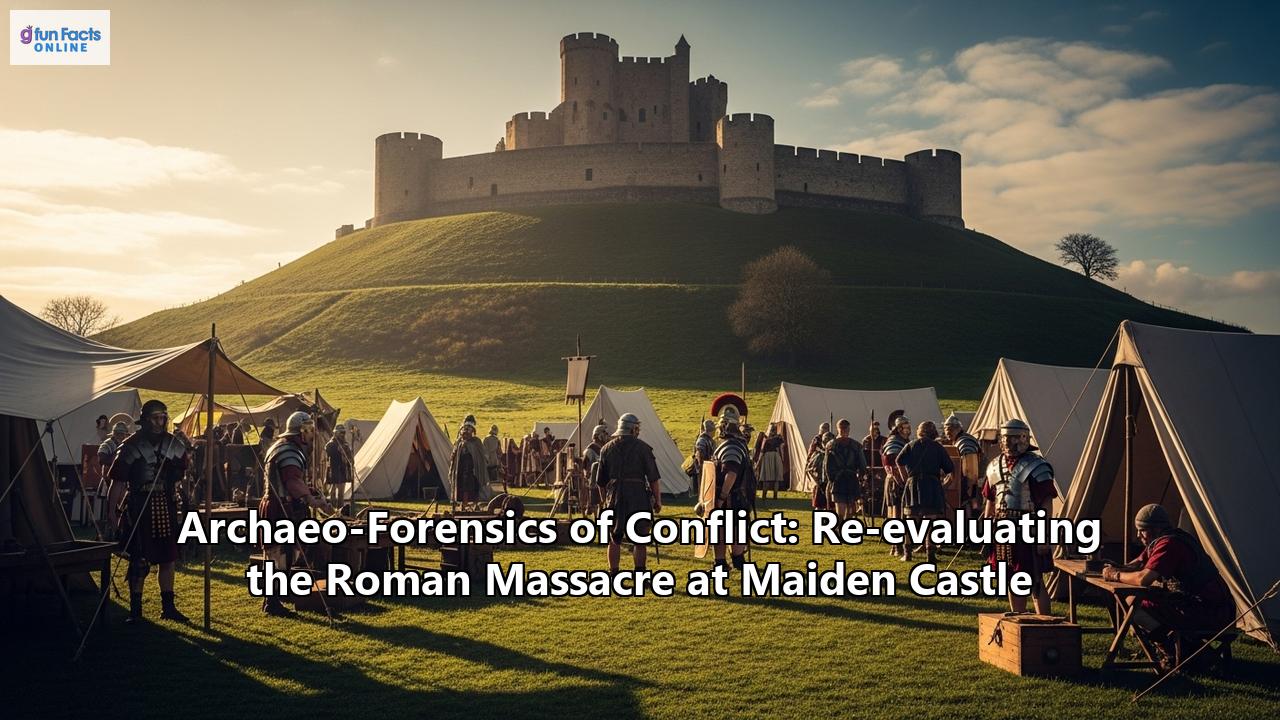For decades, the imposing Iron Age hillfort of Maiden Castle in Dorset, England, has been synonymous with a brutal Roman massacre, a vivid testament to the violent conquest of Britain. However, recent archaeo-forensic research is dramatically reshaping this narrative, suggesting a more complex and perhaps even more unsettling history of conflict at this iconic site.
The traditional story, popularized by archaeologist Sir Mortimer Wheeler following his excavations in the 1930s, painted a grim picture. He described a "war cemetery" where the remains of native Britons, members of the Durotriges tribe, were hastily buried after a fierce but ultimately futile defence against the advancing Roman legions in AD 43. The discovery of skeletons bearing horrific injuries, some with projectile points embedded in their bones, seemed to confirm this dramatic clash. One particular skeleton, with what was long believed to be a Roman ballista bolt lodged in its spine, became a potent symbol of this Roman onslaught. Wheeler's compelling account of slaughter and conquest became a fixture in historical literature and public imagination, a defining moment marking the violent end of the Iron Age in Britain.
However, a new wave of scientific analysis, employing modern forensic techniques and comprehensive radiocarbon dating programs, has cast significant doubt on this long-held interpretation. A landmark study by archaeologists from Bournemouth University, published in the Oxford Journal of Archaeology, has revealed that the individuals buried at Maiden Castle likely did not die in a single, catastrophic event attributable to a Roman attack. Instead, the evidence points to multiple episodes of lethal violence spanning several generations, from the late 1st century BC into the early 1st century AD – a period largely before the Roman legions arrived in force.
Dr. Martin Smith, Associate Professor in Forensic and Biological Anthropology at Bournemouth University, who analysed the human remains, stated, “The find of dozens of human skeletons displaying lethal weapon injuries was never in doubt. However, by undertaking a systematic programme of radiocarbon dating, we have been able to establish that these individuals died over a period of decades, rather than a single terrible event.” This crucial finding shifts the focus from a singular Roman massacre to a prolonged period of localized conflict and societal stress among the Britons themselves in the decades leading up to the Roman conquest.
The nature of the injuries observed on the skeletons – including blunt force trauma, sharp-force lesions, and embedded projectiles – while clearly indicative of violence, lacks the specific patterning and concentration that might be expected from a pitched battle against organized Roman military forces. Furthermore, the projectile previously identified as a Roman ballista bolt is now believed to be a locally made javelin point, possibly inserted as part of a ritual practice after death.
This re-evaluation suggests a period of significant internal strife, possibly dynastic power struggles, "gangland-style executions," or regional executions rather than a united front against a foreign invader. Dr. Miles Russell, Principal Academic in Prehistoric and Roman Archaeology at Bournemouth University and the study's Dig Director, commented, "This was a case of Britons killing Britons, the dead being buried in a long-abandoned fortification. The Roman army committed many atrocities, but this does not appear to be one of them." Some researchers have even described the violence as "Mafia-like families" and "Game of Thrones-like barons with one dynasty wiping out another to control trade links and protection rackets for power." Skeletons reportedly bore marks of extreme ferocity, with some skulls smashed extensively, suggesting overkill rather than single death blows in battle.
The burial practices themselves also offer clues. Variations in how the dead were interred suggest complex social dynamics, possibly indicating co-existing cultures or intricate social stratification within Iron Age society, rather than the hasty burials expected after a massacre by an invading army. Paul Cheetham, a BU Visiting Fellow and archaeological scientist, noted that "The intermingling of differing cultural burial practices contemporaneously shows that simplistic approaches to interpreting archaeological cemeteries must now be questioned."
This new understanding doesn't negate the violence that occurred at Maiden Castle but recontextualizes it. It paints a picture of a society experiencing significant internal pressures and conflict before the full impact of Roman expansion. The trauma evident on the remains of men, women, and even young people suggests that violence was a pervasive feature of life for some segments of the population during this period.
The implications of these findings extend beyond Maiden Castle itself, prompting a broader re-evaluation of how historical narratives are constructed and how they can persist, sometimes even when contradicted by emerging evidence. It also highlights the crucial role of ongoing archaeological research and the application of modern scientific methods in refining our understanding of the past.
While Sir Mortimer Wheeler's excavations were groundbreaking for their time, he was only able to investigate a fraction of the vast hillfort. Researchers believe it is likely that a larger number of burials remain undiscovered around the immense ramparts, holding further secrets to the complex history of Maiden Castle.
The story of Maiden Castle is evolving from a simple tale of heroic resistance against Roman might to a more nuanced and arguably more fascinating account of Iron Age life, fraught with internal conflict, social upheaval, and the long shadow of an impending imperial power. The archaeo-forensics of conflict are stripping away layers of myth to reveal a richer, more human, and ultimately more complex story of this iconic British landmark.
Reference:
- https://www.bournemouth.ac.uk/news/2025-05-20/roman-massacre-never-happened-according-new-study-iconic-archaeological-site
- https://www.historyextra.com/period/iron-age/the-romans-were-blamed-for-massacring-these-iron-age-warriors-but-did-they-actually-murder-themselves/
- https://archae.co.uk/bournemouth-university-study-rejects-roman-massacre-narrative-at-maiden-castle/
- https://arkeonews.net/new-study-disproves-roman-massacre-at-maiden-castle-revealing-complex-iron-age-conflicts/
- https://www.eurekalert.org/news-releases/1085092
- https://www.forensicmag.com/3594-All-News/619517-The-Roman-Massacre-that-Never-Happened/?catid=26318
- https://archaeologymag.com/2025/05/study-debunks-roman-massacre-myth-at-maiden-castle/
- https://greekreporter.com/2025/05/26/roman-massacre-theory-maiden-castle-england/
- https://www.mensjournal.com/news/dorset-iron-age-war-cemetery-maiden-castle
- https://www.researchgate.net/publication/391718737_FRAUGHT_WITH_HIGH_TRAGEDY_A_CONTEXTUAL_AND_CHRONOLOGICAL_RECONSIDERATION_OF_THE_MAIDEN_CASTLE_IRON_AGE_'WAR_CEMETERY'_ENGLAND
- https://www.english-heritage.org.uk/visit/places/maiden-castle/history/roman-invasion/
- https://www.ynetnews.com/travel/article/syurou11zgg
- https://www.gbnews.com/science/archaeology-breakthrough-mafia-style-gangland-executions-dorset-maiden-castle
- https://www.youtube.com/watch?v=n2x7hlxEdho
- https://www.yahoo.com/news/study-reveals-chilling-secret-iron-102639520.html

